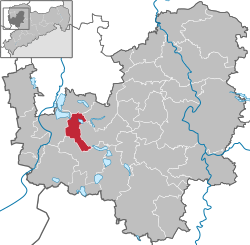Böhlen (Sachsen)
| Böhlen | ||
|---|---|---|
 |
||
|
||
| Coordinates: 51°12′9″N 12°23′9″E / 51.20250°N 12.38583°ECoordinates: 51°12′9″N 12°23′9″E / 51.20250°N 12.38583°E | ||
| Country | Germany | |
| State | Saxony | |
| District | Leipzig | |
| Government | ||
| • Mayor | Dietmar Berndt | |
| Area | ||
| • Total | 24.55 km2 (9.48 sq mi) | |
| Elevation | 126 m (413 ft) | |
| Population (2015-12-31) | ||
| • Total | 6,770 | |
| • Density | 280/km2 (710/sq mi) | |
| Time zone | CET/CEST (UTC+1/+2) | |
| Postal codes | 04564 | |
| Dialling codes | 034206, 034299 (Großdeuben) | |
| Vehicle registration | L, BNA, GHA, GRM, MTL, WUR | |
| Website | www.stadt-boehlen.de | |
Böhlen (German pronunciation: [ˈbøːlən]) is a town in the Free State of Saxony, Germany, south of Leipzig. Its main features are a small airport and a power-plant. It is located in the newly built Neuseenland, the lakes created in the former open-pit mining areas.
The first documented mention of Böhlen dates to 1353, although the area has been settled since the 7th century. The name of the town is derived from the Slavic word bely (white, bright, shiny). The manor is first mentioned in 1548. The manor house, locally referred to as the castle, was built in the 16th century. First documentation regarding the old village church dates from 1540, although the building contains Romanesque parts. A plague epidemy during the Thirty Years' War was reportedly only survived by two families.
The character of the place was rural for a long time. In 1842 a station on the Leipzig–Hof railway was opened in Böhlen. A school house with five classrooms was built in 1879. Böhlen was part of Amt Pegau until 1856, then of Gerichtsamt (judicial district) Zwenkau until 1875 and from then on of Amtshauptmannschaft (district) Leipzig.
Only from the 1920s on the village developed into an industrial location, mainly due to the lignite found in the area. In 1924 one of the largest lignite mines in the world of its time was opened west of Böhlen. It was equipped with a conveyor bridge of 200 m length and 50 m height.
Towards the end of World War II a subcamp of Buchenwald concentration camp was established, where 800 prisoners worked as forced labor in a Braunkohle-Benzin AG ("Brabag") plant. Due to the strategically important industry, Böhlen suffered heavy aerial attacks in 1944/1945.
...
Wikipedia



